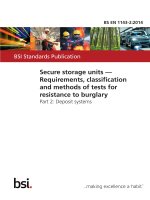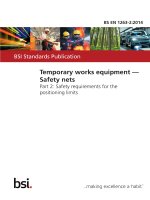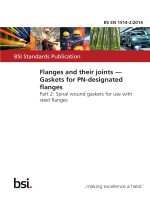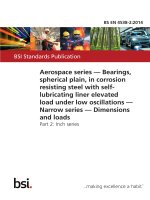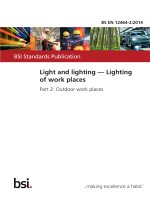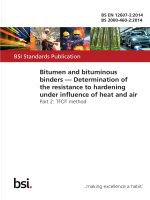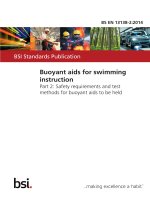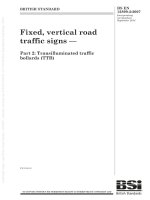Bsi bs en 62442 2 2014
Bạn đang xem bản rút gọn của tài liệu. Xem và tải ngay bản đầy đủ của tài liệu tại đây (1.13 MB, 18 trang )
BS EN 62442-2:2014
BSI Standards Publication
Energy performance of
lamp controlgear
Part 2: Controlgear for high intensity
discharge lamps (excluding fluorescent
lamps) — Method of measurement to
determine the efficiency of controlgear
BRITISH STANDARD
BS EN 62442-2:2014
National foreword
This British Standard is the UK implementation of EN 62442-2:2014. It is
identical to IEC 62442-2:2014.
The UK participation in its preparation was entrusted by Technical
Committee CPL/34, Lamps and Related Equipment, to Subcommittee
CPL/34/3, Auxiliaries for lamps.
A list of organizations represented on this committee can be obtained on
request to its secretary.
This publication does not purport to include all the necessary provisions of
a contract. Users are responsible for its correct application.
© The British Standards Institution 2014.
Published by BSI Standards Limited 2014
ISBN 978 0 580 80427 4
ICS 29.140.99
Compliance with a British Standard cannot confer immunity from
legal obligations.
This British Standard was published under the authority of the
Standards Policy and Strategy Committee on 30 June 2014.
Amendments/corrigenda issued since publication
Amd. No.
Date
Text affected
BS EN 62442-2:2014
EUROPEAN STANDARD
EN 62442-2
NORME EUROPÉENNE
EUROPÄISCHE NORM
May 2014
ICS 29.140.99
English Version
Energy performance of lamp controlgear - Part 2: Controlgear for
high intensity discharge lamps (excluding fluorescent lamps) Method of measurement to determine the efficiency of the
controlgear
(IEC 62442-2:2014)
Performance énergétique des appareillages de lampes Partie 2: Appareillages des lampes à décharge à haute
intensité (à l'exclusion des lampes à fluorescence) Méthode de mesure pour la détermination du rendement
des appareillages
(CEI 62442-2:2014)
Energieeffizienz von Lampenbetriebsgeräten - Teil 2:
Betriebsgeräte für Hochdruck-Entladungslampen
(ausgenommen Leuchtstofflampen) - Messverfahren zur
Bestimmung des Wirkungsgrades von Betriebsgeräten
(IEC 62442-2:2014)
This European Standard was approved by CENELEC on 2014-05-22. CENELEC members are bound to comply with the CEN/CENELEC
Internal Regulations which stipulate the conditions for giving this European Standard the status of a national standard without any alteration.
Up-to-date lists and bibliographical references concerning such national standards may be obtained on application to the CEN-CENELEC
Management Centre or to any CENELEC member.
This European Standard exists in three official versions (English, French, German). A version in any other language made by translation
under the responsibility of a CENELEC member into its own language and notified to the CEN-CENELEC Management Centre has the
same status as the official versions.
CENELEC members are the national electrotechnical committees of Austria, Belgium, Bulgaria, Croatia, Cyprus, the Czech Republic,
Denmark, Estonia, Finland, Former Yugoslav Republic of Macedonia, France, Germany, Greece, Hungary, Iceland, Ireland, Italy, Latvia,
Lithuania, Luxembourg, Malta, the Netherlands, Norway, Poland, Portugal, Romania, Slovakia, Slovenia, Spain, Sweden, Switzerland,
Turkey and the United Kingdom.
European Committee for Electrotechnical Standardization
Comité Européen de Normalisation Electrotechnique
Europäisches Komitee für Elektrotechnische Normung
CEN-CENELEC Management Centre: Avenue Marnix 17, B-1000 Brussels
© 2014 CENELEC All rights of exploitation in any form and by any means reserved worldwide for CENELEC Members.
Ref. No. EN 62442-2:2014 E
BS EN 62442-2:2014
EN 62442-2:2014
-2-
Foreword
The text of document 34C/1078/FDIS, future edition 1 of IEC 62442-2, prepared by SC 34C
"Auxiliaries for lamps" of IEC/TC 34 "Lamps and related equipment" was submitted to the IECCENELEC parallel vote and approved by CENELEC as EN 62442-2:2014.
The following dates are fixed:
•
latest date by which the document has
to be implemented at national level by
publication of an identical national
standard or by endorsement
(dop)
2015-02-22
•
latest date by which the national
standards conflicting with the
document have to be withdrawn
(dow)
2017-05-22
Attention is drawn to the possibility that some of the elements of this document may be the subject of
patent rights. CENELEC [and/or CEN] shall not be held responsible for identifying any or all such
patent rights.
Endorsement notice
The text of the International Standard IEC 62442-2:2014 was approved by CENELEC as a European
Standard without any modification.
In the official version, for Bibliography, the following notes have to be added for the standards
indicated:
IEC 60188
NOTE
Harmonised in EN 60188 (not modified).
IEC 60662
NOTE
Harmonised in EN 60662 (not modified).
IEC 60923
NOTE
Harmonised in EN 60923 (not modified).
IEC 61167
NOTE
Harmonised in EN 61167 (not modified).
IEC 62035
NOTE
Harmonised in EN 62035 (not modified).
IEC 62442-1:2011
NOTE
Harmonised in EN 62442-1:2011 (not modified).
IEC 62442-3
NOTE
Harmonised in EN 62442-3 (not modified).
BS EN 62442-2:2014
EN 62442-2:2014
-3-
Annex ZA
(normative)
Normative references to international publications
with their corresponding European publications
The following documents, in whole or in part, are normatively referenced in this document and are
indispensable for its application. For dated references, only the edition cited applies. For undated
references, the latest edition of the referenced document (including any amendments) applies.
NOTE 1 When an International Publication has been modified by common modifications, indicated by (mod), the relevant
EN/HD applies.
NOTE 2 Up-to-date information on the latest versions of the European Standards listed in this annex is available here:
www.cenelec.eu
Publication
Year
IEC 61347-1 (mod) 2007
+A1
+A2
IEC 61347-2-9
2010
2012
2012
IEC 61347-2-12
2010
IEC Guide 115
Title
EN/HD
Year
Lamp controlgear -Part 1: General and safety requirements
EN 61347-1
2008
+A1
+A2
EN 61347-2-9
2011
2013
2013
Lamp controlgear -Part 2-9: Particular requirements for
electromagnetic controlgear for discharge
lamps (excluding fluorescent lamps)
Lamp controlgear Part 2-12: Particular requirements for d.c.
or a.c. supplied electronic ballasts for
discharge lamps (excluding fluorescent
lamps)
Application of uncertainty of measurement to conformity assessment activities in the
electrotechnical sector
-
-
–2–
BS EN 62442-2:2014
IEC 62442-2:2014 © IEC 2014
CONTENTS
1
Scope .............................................................................................................................. 5
2
Normative references ....................................................................................................... 5
3
Terms and definitions....................................................................................................... 6
4
General ........................................................................................................................... 7
5
4.1 Applicability ............................................................................................................. 7
4.2 General notes on test .............................................................................................. 7
4.3 Controllable controlgear .......................................................................................... 7
4.4 Multi-lamp type controlgear ..................................................................................... 7
4.5 Measurement uncertainty ........................................................................................ 8
4.6 Sampling of controlgear for testing .......................................................................... 8
4.7 Number of samples ................................................................................................. 8
4.8 Power supply........................................................................................................... 8
4.9 Supply voltage waveform ......................................................................................... 8
4.10 Instrument accuracy ................................................................................................ 8
4.11 Multi-rated voltage controlgear ................................................................................ 9
Method of measurement of the input power and calculation of the efficiency of
controlgear for high intensity discharge lamps .................................................................. 9
5.1 Measurement setup: Electromagnetic wire wound controlgear .................................. 9
5.2 Efficiency calculation: Magnetic wire wound controlgear ......................................... 10
5.3 Measurement setup: Electronic controlgear ........................................................... 10
5.4 Efficiency calculation: Electronic controlgear ......................................................... 11
5.5 Standby power measurement of electronic controlgear .......................................... 11
Bibliography .......................................................................................................................... 13
Figure 1 – Measurement setup for electromagnetic controlgear ............................................... 9
Figure 2 – Measurement setup for electronic controlgear ....................................................... 10
Figure 3 – Measurement setup of the standby power of electronic controlgear ....................... 11
Table 1 – Typical nominal electricity supply details for some regions ........................................ 8
BS EN 62442-2:2014
IEC 62442-2:2014 © IEC 2014
–5–
ENERGY PERFORMANCE OF LAMP CONTROLGEAR –
Part 2: Controlgear for high intensity discharge lamps
(excluding fluorescent lamps) – Method of measurement
to determine the efficiency of the controlgear
1
Scope
This part of the IEC 62442 series defines a measurement method of the power losses of
electromagnetic controlgear, the total input power and the standby power of electronic
controlgear for high intensity discharged lamps (excluding fluorescent lamps). Also a
calculation method of the efficiency for controlgear for high intensity discharged lamp(s) is
defined.
This International Standard applies to electrical controlgear – lamp circuits comprised solely of
the controlgear and of the lamp(s).
NOTE
Requirements for testing individual controlgear during production are not included.
It specifies the measurement method for the total input power, the standby power and the
calculation method of the lamp controlgear efficiency for all controlgear sold for domestic and
normal commercial purposes operating with high intensity discharge lamps.
This International Standard does not apply to:
–
controlgear which form an integral part of lamps;
–
controlgear circuits with capacitors connected in series;
–
controllable wire-wound electromagnetic controlgear.
2
Normative references
The following documents, in whole or in part, are normatively referenced in this document and
are indispensable for its application. For dated references, only the edition cited applies. For
undated references, the latest edition of the referenced document (including any amendments)
applies.
IEC 61347-1:2007, Lamp controlgear – Part 1: General and safety requirements
Amendment 1:2010
Amendment 2:2012
IEC 61347-2-9:2012, Lamp controlgear – Part 2-9: Particular requirements for electromagnetic
controlgear for discharge lamps (excluding fluorescent lamps)
IEC 61347-2-12:2010, Lamp controlgear – Part 2-12: Particular requirements for d.c. or a.c.
supplied electronic ballasts for discharge lamps (excluding fluorescent lamps)
IEC Guide 115:2007, Application of uncertainty of measurement to conformity assessment
activities in the electrotechnical sector
–6–
3
BS EN 62442-2:2014
IEC 62442-2:2014 © IEC 2014
Terms and definitions
For the purpose of this document, the following terms and definitions apply.
3.1
nominal value
suitable approximate quantity value used to designate or identify a component, device or
equipment
[SOURCE: IEC 62442-1:2011,3.1]
3.2
rated value
quantity value for specified operating conditions of a component, device or equipment. The
value and conditions are specified in the relevant standard or assigned by the manufacturer or
responsible vendor
[SOURCE: IEC 62442-1:2011, 3.3, modified – The note has been removed.]
3.3
controlgear
one or more components between supply and one or more lamps which may serve to transform
the supply voltage, limit the current of lamp(s) to the required value, provide starting voltage,
correct power factor or reduce radio interference
[SOURCE: IEC 62442-1:2011,3.4]
3.4
electromagnetic controlgear
controlgear which by means of inductance, or a combination of inductance and capacitance,
serves mainly to limit the current of lamp(s) to the required value
Frequency of the lamp controlgear is the same as supply frequency
[SOURCE: IEC 62442-1:2011,3.5]
3.5
electronic controlgear, <used for high intensity discharge lamps>
A.C. and/or D.C. supplied electronic circuit including stabilizing elements for starting and
operating one or more lamp(s)
3.6
discharge lamp
lamp in which the light is produced, directly or indirectly, by an electric discharge through a
gas, a metal vapour or a mixture of several gases and vapours
3.7
controlgear – lamp circuit
electrical circuit, or part thereof, normally built in a luminaire, consisting of the controlgear and
lamp(s)
[SOURCE: IEC 62442-1:2011,3.8]
3.8
standby mode
mode relevant for those controlgear which are permanently connected to the mains, where the
lamp(s) are switched off via a control signal, not including failed lamp(s)
BS EN 62442-2:2014
IEC 62442-2:2014 © IEC 2014
Note 1 to entry:
–7–
The ignition phase of lamp(s) is excluded from the standby mode.
3.9
standby power
average power consumption of a controlgear when subjected to standby mode
Note 1 to entry:
Unit: W.
3.10
total input power
total power supplied to the controlgear – lamp circuit measured at rated input voltage
[SOURCE: CEI 62442-1:2011, 3.14, modified – The sentence "The rated power specified is
related to a specific ballast lumen factor (BLF)." has been removed.]
3.11
lamp controlgear efficiency, <for controlgear used for high intensity discharge lamps>
η MCG
η ECG
ratio between the lamp power (controlgear output power) and the input power of the
controlgear – lamp circuit with possible sensors, network connections and other auxiliary loads
disconnected
3.12
multi-lamp type controlgear
controlgear designed for the operation of more than one type of lamp with different electrical
characteristics e.g. power
4
4.1
General
Applicability
The measurement and calculation methods of this International Standard shall only be used for
lamp controlgear which conforms to IEC 61347-1 with IEC 61347-2-9 or IEC 61347-1 with
IEC 61347-2-12.
4.2
General notes on test
The measurement conditions are specified in IEC 61347-1:2007, Clauses H.1, H.2, H.4, H.8,
H.9 and H.11; unless otherwise specified in this standard. The device under test (DUT) shall be
placed according to IEC 61347-1:2007, Figure H.1.
An A.C. voltage source shall be used to provide input voltage to the DUT. During the tests, the
supply voltage and the frequency shall be maintained constant within ± 0,5 % during the warmup period. However, during the actual measurement, the voltage shall be adjusted to within
± 0,2 % of the specified testing value.
4.3
Controllable controlgear
Requirements for other than 100 % light output operation of controllable controlgear and multitapped electromagnetic controlgear are under consideration.
4.4
Multi-lamp type controlgear
If a single-lamp controlgear is designed for different lamp powers then the test shall be carried
out for each lamp.
The test for multi-lamp controlgear shall be carried out with all possible combinations.
–8–
4.5
BS EN 62442-2:2014
IEC 62442-2:2014 © IEC 2014
Measurement uncertainty
Measurement uncertainty shall be managed in accordance with the accuracy method in 4.4.3 of
the IEC Guide 115:2007.
4.6
Sampling of controlgear for testing
Tests in this International Standard are type tests. The requirements and tolerances specified
in this International Standard are based on the testing of a type test sample submitted by the
manufacturer for that purpose. This sample should consist of units having characteristics
typical of the manufacturer’s production and be as close to the production centre point values
as possible.
4.7
Number of samples
One specimen shall be tested.
4.8
Power supply
Where the test voltage and frequency are not defined by national or regional requirements, the
controlgear manufacturer shall declare the nominal voltage(s) at which the given efficiency is
valid.
Test voltage(s) and test frequency(ies) shall be the nominal voltage and the nominal frequency
of the country or region for which the measurement is being determined (refer to Table 1).
Table 1 – Typical nominal electricity supply details for some regions
Country or region
Europe
Nominal voltage and frequency
230 V; 50 Hz
North America
120 V, 277 V; 60 Hz
b
100 V, 200 V; 50/60 Hz
Japan
a
China
220 V; 50 Hz
Australia and New Zealand
230 V: 50 Hz
a
Values are for single phase only. Some single phase supply voltages can be double the nominal voltage
above (centre transformer tap). The voltage between two phases of a three-phase system is 1,73 times single
phase values (e.g. 400 V for Europe).
b
50 Hz is applicable for the Eastern part and 60 Hz for the Western part, respectively.
4.9
Supply voltage waveform
The total harmonic content of the supply voltage when supplying the DUT shall not exceed 3 %;
harmonic content is defined as the root-mean-square (r.m.s.) summation of the individual
components using the fundament as 100 %.
The ratio of peak value to r.m.s. value of the test voltage (i.e. crest factor) shall be between
1,34 and 1,49.
4.10
Instrument accuracy
For magnetic wire wound controlgear, calibrated and traceable a.c. power meters, power
analysers or digital power meters shall be used.
For electronic controlgear, all output power measurements shall be made with a calibrated and
traceable wideband power analyser or digital power meter.
BS EN 62442-2:2014
IEC 62442-2:2014 © IEC 2014
–9–
For measurements made under the scope of this standard, measurement instruments with the
following minimum accuracies are to be used:
•
Voltage: 0,5 %
•
Current: 0,5 %
•
Power: 1,0 %
•
Frequency: 0,1 %
Stability of the measurement values (V, A or W) is given if the data does not differ by more
than 1 % in a time frame of 15 min.
4.11
Multi-rated voltage controlgear
If a controlgear is designed for more than one rated voltage, the controlgear manufacturer shall
declare the rated voltage(s) at which the given efficiency is valid.
5
5.1
Method of measurement of the input power and calculation of the efficiency
of controlgear for high intensity discharge lamps
Measurement setup: Electromagnetic wire wound controlgear
Figure 1 shows the measurement setup of the power losses of electromagnetic wire wound
controlgear.
DUT
Test
voltage
IEC 1136/14
Key
DUT
Device under test
Figure 1 – Measurement setup for electromagnetic controlgear
The power losses (P losses ) of the electromagnetic controlgear will be measured based on the
rated lamp current through the electromagnetic controlgear. Therefore the current through the
electromagnetic controlgear will be adjusted by the test voltage to the current defined in the
data sheet of the lamp(s). Tolerance for the current is ± 1 %.
The measurements are carried out with a power meter connected to measure the power losses
into the electromagnetic controlgear.
The value of the power losses (P losses ) is recorded when a steady state has been reached
(temperature of the electromagnetic controlgear).
Measurement sequence:
1) Connect the DUT according to Figure 1.
2) Switch on the supply voltage and adjust the output voltage of the transformer until the rated
lamp current is obtained.
3) Await the thermal equilibrium and if necessary adjust the voltage of the transformer again
to match the rated lamp current.
4) Measure the power losses.
– 10 –
BS EN 62442-2:2014
IEC 62442-2:2014 © IEC 2014
NOTE In case of independent electromagnetic controlgear which incorporates an ignitor in the same enclosure,
the test is only applicable to the electromagnetic controlgear.
The measurement setup circuit for constant power controlgear shall be used in suitable way
also with the current defined in the data sheets of the lamp(s).
5.2
Efficiency calculation: Magnetic wire wound controlgear
For the calculation of the efficiency of electromagnetic controlgear (η MCG ), Equation (1) should
be used:
η MCG =
Plamp.rated
Plamp.rated + Plosses
(1)
where
P lamp,rated
5.3
is the lamp power given in the lamp datasheet (in watt).
Measurement setup: Electronic controlgear
Figure 2 illustrates the measurement setup of the input and the output power of electronic
controlgear.
Supply
voltage
DUT
Rload
IEC 1137/14
Key
DUT
Device under test
R load
Lamp replacement resistor = Load resistor
NOTE Due to the unstable lamp situation for high intensity discharge lamps and for a good reproducibility as a
replacement for the lamps a resistor (R load ) is used.
Figure 2 – Measurement setup for electronic controlgear
If R load is not given on the lamp data sheet, R load is determined by dividing the rated/typical
lamp voltage squared by the rated/typical lamp power. The value of the resistance shall be
noted in the measurement report.
The measurements are carried out with power meters connected to measure the total input
power into the electronic controlgear – lamp circuit and the output power of the controlgear
(lamp power).
The value of the total input power (P tot.meas . ) is recorded when the temperature of the
controlgear is stable. The temperature shall not differ by more than 1 K per hour.
The supply voltage for the measurement according Figure 2 is defined in 4.8 of this standard.
Measurement sequence:
1) Connect the DUT according Figure 2.
2) Switch on the mains voltage.
3) Await the thermal equilibrium.
BS EN 62442-2:2014
IEC 62442-2:2014 © IEC 2014
– 11 –
4) Measure the input and the output power.
To obtain a more accurate value of the efficiency, the R load should be obtained taking into
consideration the typical lamp voltage and current for square wave operation.
The measured total input power (P tot.meas . ) of a controlgear – lamp circuit is measured with
one electronic lamp controlgear.
P tot.meas . is the measured total input power into the controlgear – lamp circuit under test (in
watts)
P Lamp
5.4
is the measured output power of the controlgear under test (lamp power = power at
the substitution resistor) in the test circuit (in watts).
Efficiency calculation: Electronic controlgear
For the calculation of the efficiency of controlgear (η ECG ), Equation (2) should be used:
η ECG =
5.5
PLamp .
Ptot.meas .
(2)
Standby power measurement of electronic controlgear
Figure 3 illustrates the measurement setup of the standby power of electronic controlgear.
Interface port
Supply
voltage
DUT
Output
terminals
IEC 1138/14
Key
DUT
Device under test
Figure 3 – Measurement setup of the standby power of electronic controlgear
The output circuit (terminals) of the controlgear is open (not connected to a substitution
resistor).
The measurements are carried out with a power meter connected to measure the total input
power into the electronic controlgear.
If a controlgear is also designed for functions other than lamp operation, all these additional
functions shall be switched-off during the test.
NOTE
Controlgear with additional power supply for the digital addressable lighting interface could be possible.
The value of the standby power (P ECGstandby ) (total input power) is recorded when a steady
state has been reached (temperature of the electronic controlgear).
The supply voltage for the measurement according Figure 3 is defined in 4.8 of this standard.
– 12 –
BS EN 62442-2:2014
IEC 62442-2:2014 © IEC 2014
If the stand-by power varies within the time, the power is determined as the arithmetic mean
value over a sufficient period.
Measurement sequence:
1) Connect the DUT according Figure 3.
2) Switch on the mains voltage.
3) Control the output power of the electronic controlgear via the interface port (for example
“digital addressable lighting interface”) to the standby mode.
4) Await the thermal equilibrium.
5) Measure the standby power (total input power).
BS EN 62442-2:2014
IEC 62442-2:2014 © IEC 2014
– 13 –
Bibliography
IEC 60188, High-pressure mercury vapour lamps – Performance specifications
IEC 60662, High-pressure sodium vapour lamps – Performance specifications
IEC 60923, Auxiliaries for lamps – Ballasts for discharge lamps (excluding tubular fluorescent
lamp) – Performance requirements
IEC 61167, Metal halide lamps – Performance specification
IEC 62035, Discharge lamps (excluding fluorescent lamps) – Safety specifications
IEC 62442-1:2011, Energy performance of lamp controlgear – Part 1: Controlgear for
fluorescent lamps – Method of measurement to determine the total input power of controlgear
circuits and the efficiency of the controlgear
IEC 62442-3 1, Energy performance of lamp controlgear – Part 3: Controlgear for halogen
lamps and LED modules – Method of measurement to determine the efficiency of the
controlgear
_____________
_______________
1
To be published.
This page deliberately left blank
This page deliberately left blank
NO COPYING WITHOUT BSI PERMISSION EXCEPT AS PERMITTED BY COPYRIGHT LAW
British Standards Institution (BSI)
BSI is the national body responsible for preparing British Standards and other
standards-related publications, information and services.
BSI is incorporated by Royal Charter. British Standards and other standardization
products are published by BSI Standards Limited.
About us
Revisions
We bring together business, industry, government, consumers, innovators
and others to shape their combined experience and expertise into standards
-based solutions.
Our British Standards and other publications are updated by amendment or revision.
The knowledge embodied in our standards has been carefully assembled in
a dependable format and refined through our open consultation process.
Organizations of all sizes and across all sectors choose standards to help
them achieve their goals.
Information on standards
We can provide you with the knowledge that your organization needs
to succeed. Find out more about British Standards by visiting our website at
bsigroup.com/standards or contacting our Customer Services team or
Knowledge Centre.
Buying standards
You can buy and download PDF versions of BSI publications, including British
and adopted European and international standards, through our website at
bsigroup.com/shop, where hard copies can also be purchased.
If you need international and foreign standards from other Standards Development
Organizations, hard copies can be ordered from our Customer Services team.
Subscriptions
Our range of subscription services are designed to make using standards
easier for you. For further information on our subscription products go to
bsigroup.com/subscriptions.
With British Standards Online (BSOL) you’ll have instant access to over 55,000
British and adopted European and international standards from your desktop.
It’s available 24/7 and is refreshed daily so you’ll always be up to date.
You can keep in touch with standards developments and receive substantial
discounts on the purchase price of standards, both in single copy and subscription
format, by becoming a BSI Subscribing Member.
PLUS is an updating service exclusive to BSI Subscribing Members. You will
automatically receive the latest hard copy of your standards when they’re
revised or replaced.
To find out more about becoming a BSI Subscribing Member and the benefits
of membership, please visit bsigroup.com/shop.
With a Multi-User Network Licence (MUNL) you are able to host standards
publications on your intranet. Licences can cover as few or as many users as you
wish. With updates supplied as soon as they’re available, you can be sure your
documentation is current. For further information, email
BSI Group Headquarters
389 Chiswick High Road London W4 4AL UK
We continually improve the quality of our products and services to benefit your
business. If you find an inaccuracy or ambiguity within a British Standard or other
BSI publication please inform the Knowledge Centre.
Copyright
All the data, software and documentation set out in all British Standards and
other BSI publications are the property of and copyrighted by BSI, or some person
or entity that owns copyright in the information used (such as the international
standardization bodies) and has formally licensed such information to BSI for
commercial publication and use. Except as permitted under the Copyright, Designs
and Patents Act 1988 no extract may be reproduced, stored in a retrieval system
or transmitted in any form or by any means – electronic, photocopying, recording
or otherwise – without prior written permission from BSI. Details and advice can
be obtained from the Copyright & Licensing Department.
Useful Contacts:
Customer Services
Tel: +44 845 086 9001
Email (orders):
Email (enquiries):
Subscriptions
Tel: +44 845 086 9001
Email:
Knowledge Centre
Tel: +44 20 8996 7004
Email:
Copyright & Licensing
Tel: +44 20 8996 7070
Email:

